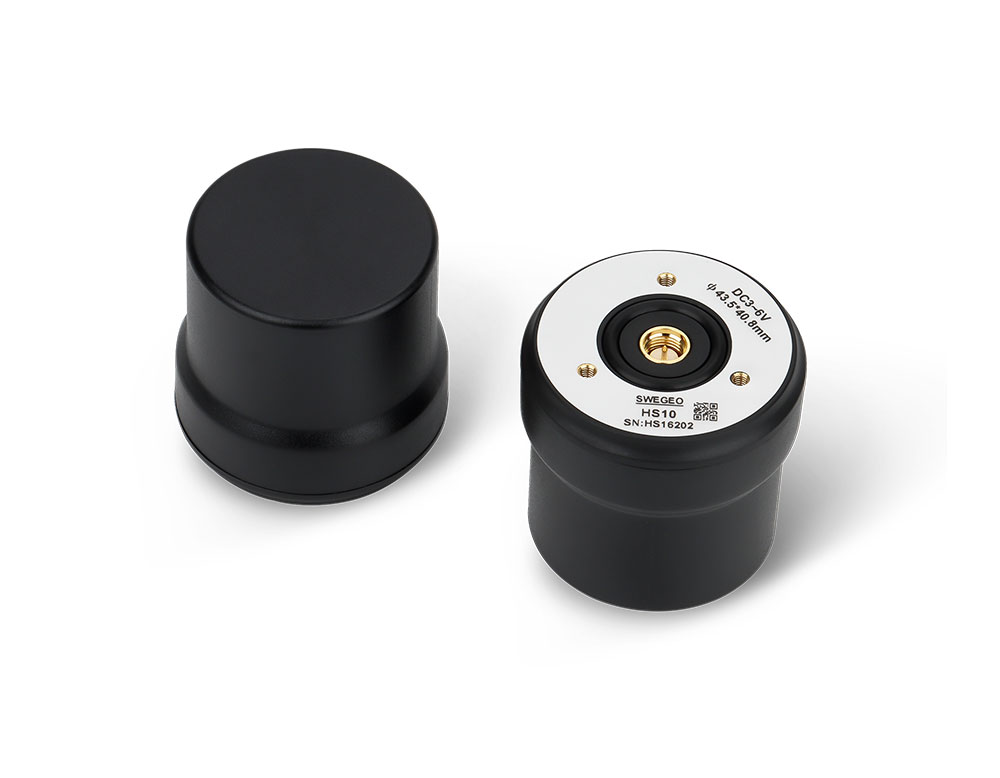
Swegeo HS10
Helical GNSS Antenna
Key Feature
Swegeo HS10 is a multi-constellation and multi-frequency Helical GNSS antenna with eight-arm coupling and four-feed point technology that supports GPS, GLONASS, GALILEO, BEIDOU, QZSS, IRNSS, SBAS and L-Band.
High Gain Reception & Reliable Low-Noise Amplifier for Optimal Satellite Tracking
It fits into any application that requires a small size and lightweight antenna without sacrificing high performance in high-precision positioning, particularly in UAV, pocket-size RTK, handheld/tablet, or other portable system applications.
Enhanced Performance and Precision
Multi-arm spiral technology ensures high performance on right-hand circular polarization and phase center stability. It further lowers the measurement errors.
Optimized Reception
The overall design provides a high gain on low-elevation satellite signal reception so that a higher number of satellites are available for position calculation.
Improved Signal Quality
Built-in low-noise amplifier, two-stage filter, good out-of-band suppression strong anti-interference ability provide fully reliable antenna performance in harsh electromagnetic environments.
Versatile and Durable
It is small in size, lightweight, and easy to carry and install.
Drone & UAV Systems:
The HS10 provides a balance of small size and high performance, making it popular for mid-size drones and unmanned systems. Drone manufacturers use HS10 on UAVs that require better gain than the tiniest antennas can offer, but still need to save weight. For example, a quadcopter used for precision mapping might mount an HS10 to improve satellite reception at low elevations, reducing RTK dropouts when the drone banks or flies near obstructions. The built-in LNA and filtering of the HS10 ensure the drone’s onboard radios (for telemetry or video) don’t drown out the weak GNSS signals, resulting in more stable positioning during complex flights.
Portable Reference Stations:
Some field teams set up makeshift reference “base” receivers using small helical antennas like the HS10 when a full survey antenna is impractical. Because the HS10 is easy to transport and can be attached to a pole or vehicle roof, a team doing a quick RTK job in a remote area could deploy an HS10 on a telescopic pole as their base antenna. Despite its compactness, it will track all needed satellites and its robust design can handle outdoor conditions temporarily. While its precision won’t match a large choke-ring antenna for long-term bases, it’s sufficient for short-term, local projects and vastly more convenient to carry on foot into rugged terrain.
Rugged Handheld GNSS Receivers:
Similar to the HA20, the HS10 targets portable use, but since it’s slightly larger (about 43 mm diameter), it offers even higher gain. Manufacturers of rugged sub-centimeter receivers or smart antennas for fieldwork may choose HS10 to ensure their unit performs under canopy, in mines, or near buildings. A utility mapping crew, for example, could use a compact receiver with an HS10 to locate underground cables precisely in a suburban neighborhood – the antenna’s multi-frequency capability and strong signal retention help maintain a fixed RTK solution near houses and trees. The HS10’s screw-mount base also gives product designers flexibility to secure it firmly to their device’s housing for superior impact resistance.
| Feature | Specification | Feature | Specification |
|---|---|---|---|
| Signal Supported |
GPS: L1/L2/L5 GLONASS: G1/G2/G3 BEIDOU: B1/B2/B3 GALILEO: E1/E5a/E5b/E6 QZSS: L1/L2/L5 IRNSS: L1/L2/L5 SBAS: L1/L2/L5 L-Band |
Architecture | Quadrifilar Helix |
| Nominal Impedance | 50 Ω | Polarization | RHCP |
| Axial Ratio @ zenith | ≤1.5 dB | Gain @ zenith | ≥2.5 dBi |
| Dimensions | Φ43.5 mm × 40.8 mm | Connector | SMA-J |
| Weight | 32 gram | Radome | ABS+PC |
| Attachment | 3 screws on base | Frequency Range | 1164 MHz ~ 1278 MHz, 1525 MHz ~ 1615 MHz |
| LNA Gain* | 35 ± 3.0 dB (Typ. @25°C) | Noise Figure* | ≤1.5 dB @25°C, Typ. |
| Output VSWR | ≤1.8:1 typ., 2.0:1 max | Operation Voltage | 3.0 ~ 16 VDC |
| Operation Current | ≤45 mA | Operating Temperature | -40°C to +85°C |
| Storage Temperature | -45°C to +85°C | Humidity | 95% Non-condensing |
| Ingress Rating | IP67 |

Swegeo HS10
Helical GNSS Antenna
Key Feature
The Swegeo HS90 is a high-performance GNSS spiral antenna designed with multi-arm, multi-feed point technology.
It supports multi-constellation and multi-frequency signals, ensuring robust and accurate positioning.
Compatible systems include GPS, GLONASS, GALILEO, BEIDOU, QZSS, IRNSS, SBAS, and L-Band.
OVERVIEW
Multi-Constellation GNSS Support
Provides reliable and robust signal reception from GPS, GLONASS, Galileo, and
BeiDou systems, ensuring comprehensive coverage and improved accuracy.
Dual Antenna Configuration
Enhances positioning accuracy and performance, particularly in challenging
environments, by using two antennas to better mitigate signal obstructions and
multipath effects.
USE CASES
Drone & UAV Systems:
The HS10 provides a balance of small size and high performance, making it popular for mid-size drones and unmanned systems. Drone manufacturers use HS10 on UAVs that require better gain than the tiniest antennas can offer, but still need to save weight. For example, a quadcopter used for precision mapping might mount an HS10 to improve satellite reception at low elevations, reducing RTK dropouts when the drone banks or flies near obstructions. The built-in LNA and filtering of the HS10 ensure the drone’s onboard radios (for telemetry or video) don’t drown out the weak GNSS signals, resulting in more stable positioning during complex flights.
Portable Reference Stations:
Some field teams set up makeshift reference “base” receivers using small helical antennas like the HS10 when a full survey antenna is impractical. Because the HS10 is easy to transport and can be attached to a pole or vehicle roof, a team doing a quick RTK job in a remote area could deploy an HS10 on a telescopic pole as their base antenna. Despite its compactness, it will track all needed satellites and its robust design can handle outdoor conditions temporarily. While its precision won’t match a large choke-ring antenna for long-term bases, it’s sufficient for short-term, local projects and vastly more convenient to carry on foot into rugged terrain.
Rugged Handheld GNSS Receivers:
Similar to the HA20, the HS10 targets portable use, but since it’s slightly larger (about 43 mm diameter), it offers even higher gain. Manufacturers of rugged sub-centimeter receivers or smart antennas for fieldwork may choose HS10 to ensure their unit performs under canopy, in mines, or near buildings. A utility mapping crew, for example, could use a compact receiver with an HS10 to locate underground cables precisely in a suburban neighborhood – the antenna’s multi-frequency capability and strong signal retention help maintain a fixed RTK solution near houses and trees. The HS10’s screw-mount base also gives product designers flexibility to secure it firmly to their device’s housing for superior impact resistance.
TECHNICAL SPECIFICATIONS
| Feature | Specification | Feature | Specification |
|---|---|---|---|
| Signal Supported |
GPS: L1/L2/L5 GLONASS: G1/G2/G3 BEIDOU: B1/B2/B3 GALILEO: E1/E5a/E5b/E6 QZSS: L1/L2/L5 IRNSS: L1/L2/L5 SBAS: L1/L2/L5 L-Band |
Architecture | Quadrifilar Helix |
| Nominal Impedance | 50 Ω | Polarization | RHCP |
| Axial Ratio @ zenith | ≤1.5 dB | Gain @ zenith | ≥2.5 dBi |
| Dimensions | Φ43.5 mm × 40.8 mm | Connector | SMA-J |
| Weight | 32 gram | Radome | ABS+PC |
| Attachment | 3 screws on base | Frequency Range | 1164 MHz ~ 1278 MHz, 1525 MHz ~ 1615 MHz |
| LNA Gain* | 35 ± 3.0 dB (Typ. @25°C) | Noise Figure* | ≤1.5 dB @25°C, Typ. |
| Output VSWR | ≤1.8:1 typ., 2.0:1 max | Operation Voltage | 3.0 ~ 16 VDC |
| Operation Current | ≤45 mA | Operating Temperature | -40°C to +85°C |
| Storage Temperature | -45°C to +85°C | Humidity | 95% Non-condensing |
| Ingress Rating | IP67 |




